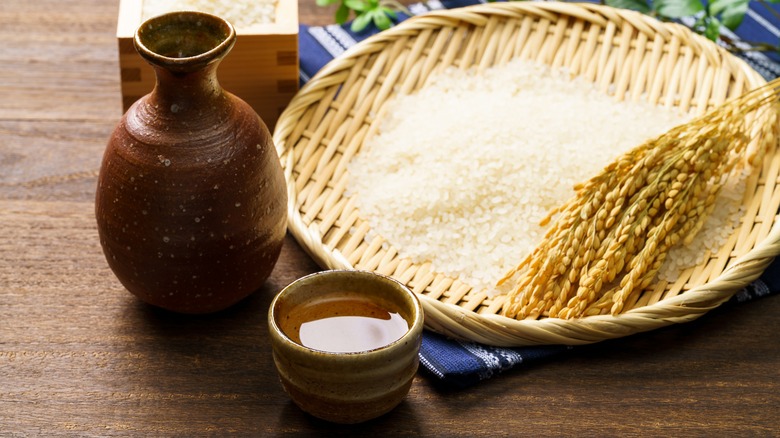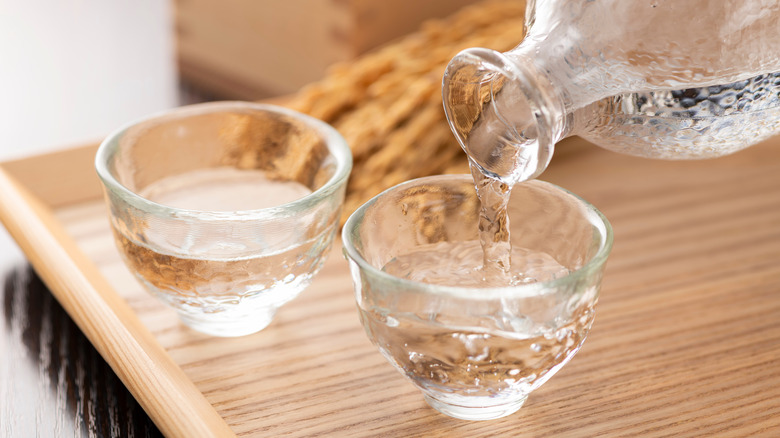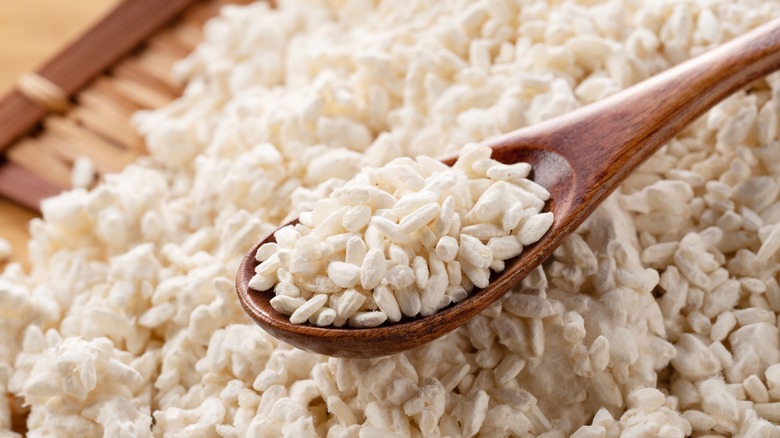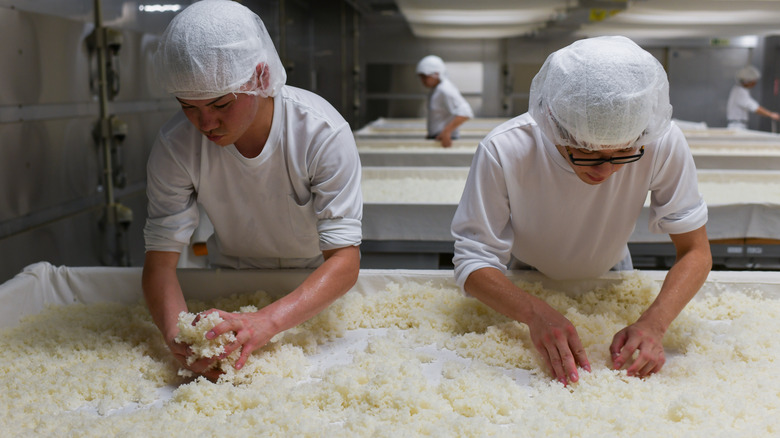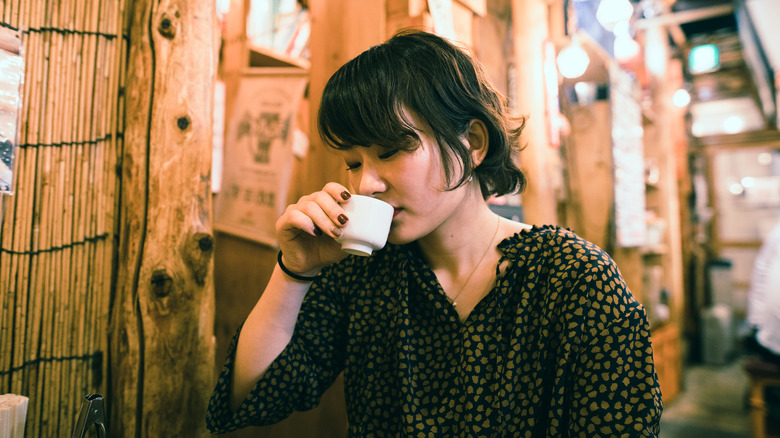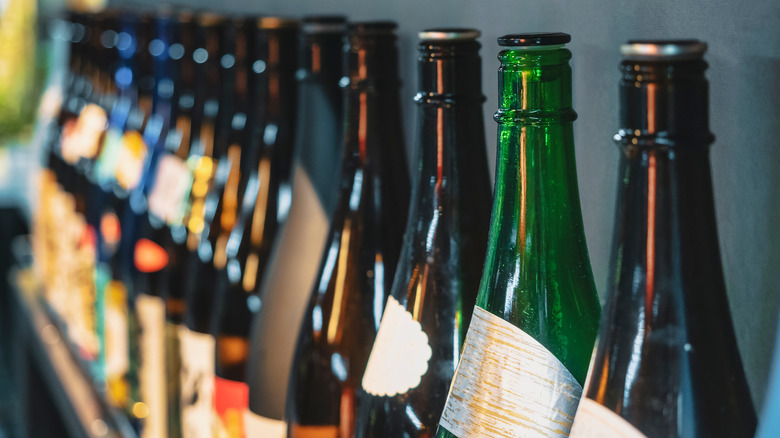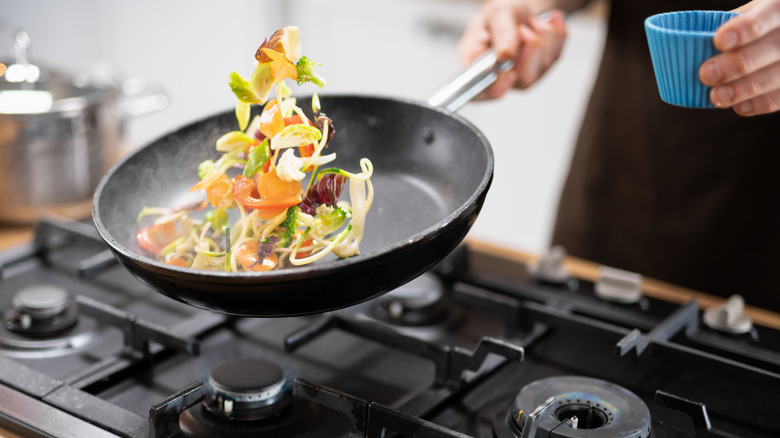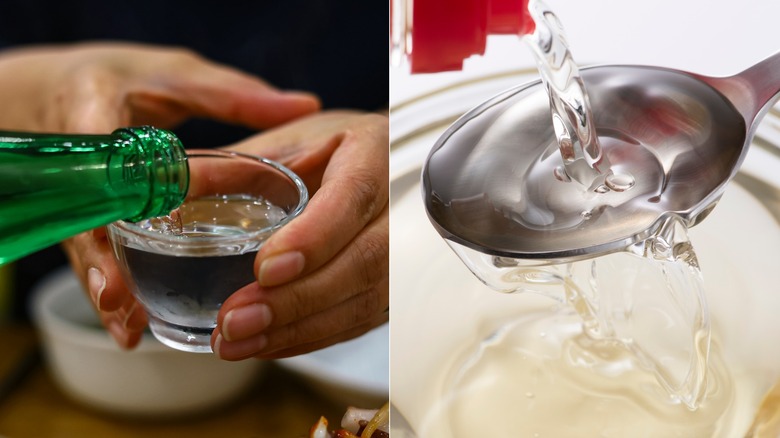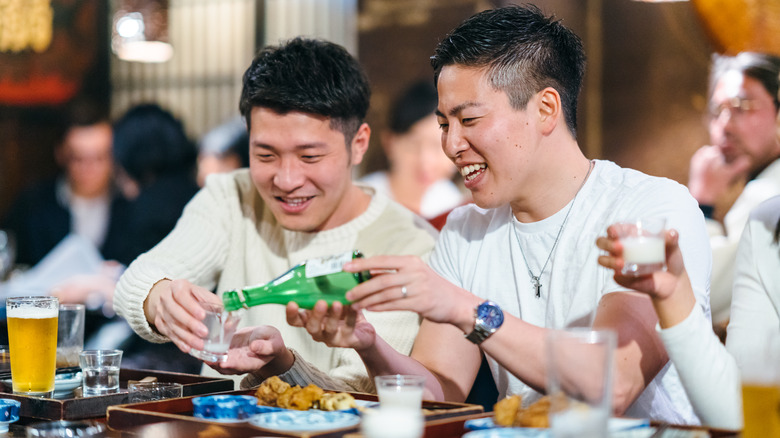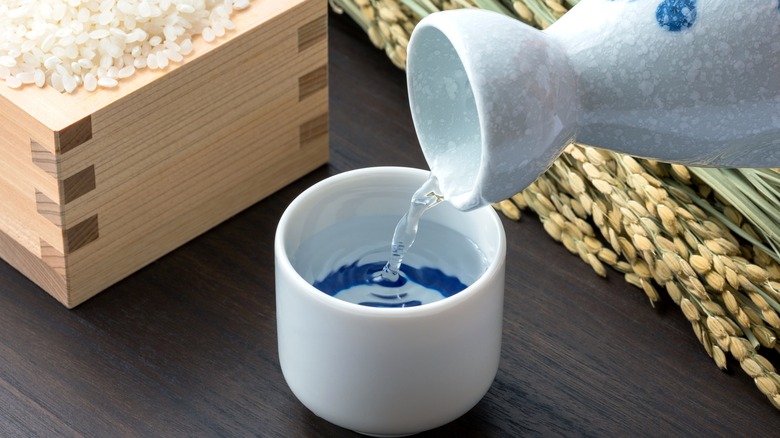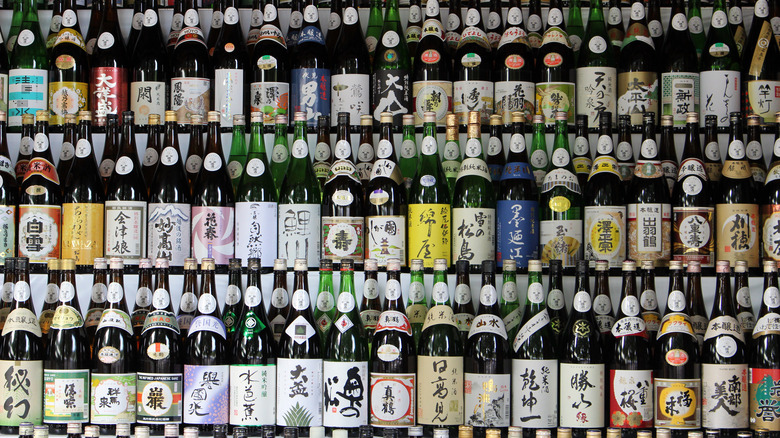Sake Is The Japanese Drink Used For Sipping And Cooking
Almost every country on earth has a special, alcoholic beverage they call their own. The United States has bourbon, France has champagne, Scotland has single malt scotch. But of all the places to visit in this world, there is not a country more connected to its special drink than Japan. The Eastern Asian island nation is nothing if not highly traditional, and sake is the most traditional drink there is in Japan.
Perfect for sipping and fantastic in cooking, sake is Japan's national drink. It is an integral part of Japanese culture that serves not just as a drink for enjoyment, but as a drink with religious significance. As a result of its thousands of years of history, the highly involved process of making sake has become highly refined. Derived from a base of rice, water, and a special fermenting agent, sake is a rice-based alcohol that has become easy to find, great to cook with, and a joy to drink.
Sake, however, is not a subject that is easily tackled. There are many layers to its story, ones that need to be peeled back steadily in order to be fully appreciated. Read on for some of the details; you might just end up chomping at the bit to fly to Japan and try some for yourself.
What is sake?
To refer to sake as rice wine is a bit of a misnomer. Since sake is derived from a grain, it shares more in common with whiskey and beer than it does with traditional grape wine. Believed to have first been made in Japan during the Yayoi Period in 300 BC, sake has gone through several transformations to become the beloved drink it is today. The key ingredient, rice, was brought to Japan by way of China. As agricultural practices and technology innovated, so too did the production of sake.
Called nihonshu in Japan — in Japanese, the word "sake" can refer to any type of alcohol — there is not much to visually distinguish sake from other clear spirits. It is derived from a basic recipe of rice, water, and a mold known as Koji (Aspergillus oryzae). Similar to beer in that it is made via multiple parallel fermentation — grain turns to starch turns to sugar turns to alcohol — the end result is a clear, fragrant spirit that has both religious and culinary significance.
Like grape wine, sake can come in sweet or dry varieties. It has applications across multiple areas of cuisine, and is known to pair well with a number of different foods, particularly fish. The actual fermentation process, however, is by far the most complicated of any alcohol. A whole series of events need to happen before sake is bottled. It all begins with the rice.
How sake is made - polishing the rice
Sake always begins with rice. While it could theoretically be made with any type of rice, the best types for sake are premium medium grain brown rices, like japonica and sakamai, which have thick, white, starchy hearts. This is highly important for the fermentation process.
Another highly important component to sake production is the polishing of the rice. This process consists of removing the outer bran and germ of the grain, thereby exposing the inner starch core. This, in turn, makes fermenting the rice far easier. The degree to which the rice is polished directly relates to how much water the rice will absorb. Most commercial sakes are polished to about 70%, meaning that only 30% of the outer bran and germ have been removed. More premium sakes require more polishing. Ginjo sakes are derived from rice that has had at least 40% of its grain polished away, while Daiginjo requires 50% or more. More polishing, it is thought, produces more flavorful sake. However, some brewers believe there is more flavor in the other layers, and keep more of the rice intact.
This is only the beginning of the very involved process of making sake. The polishing is important because it dictates the level of fermentation the rice will go through. The more starch that is exposed, the more water gets absorbed, and more sugar gets fermented. Once the rice is properly prepared, the actual brewing can commence.
How sake is made - the brewing process
The sake brewing process begins with the washing of the polished rice. Getting this right is important, as too much water can change the nature of the sake and make for an inconsistent product. The water itself is also of great importance, as minerals and chemicals can affect the fermentation process.
Next, the rice is steamed to be soft and begin the release of the starch. Some of the rice is then separated and mixed with the Koji. This is a fungus mold that releases enzymes in the rice necessary to convert the starch into sugars. This is a temperature and time sensitive process, and can take up to a few days for the fermentation to truly begin. Once it has, the infusion, called Koji Kome, is added back into the rice.
Water is added to form a fermentation mash called Shubo, the mother of alcohol. The Shubo is continually fed with a mixture of Koji Kome, steamed rice, and water in stages over the course of several weeks or months. The temperature is kept low to gradually release the sugars, which turns into alcohol.
Once the Shubo reaches the point where it can be pressed, it is filtered, and often pasteurized in order to remove any overly bitter flavors and kill any remaining Koji mold. This raw sake is aged in barrels for several months before going through another pasteurization process, and it is then bottled.
What does sake taste like?
Like any other alcohol, the taste of sake is somewhat objective. From an official standpoint, however, sake is graded on a scale known as nihonshudo, which gauges sweetness and dryness. The scale runs from – 10, meaning maximum sweetness, to + 10, meaning maximum dryness. The dryness corresponds to the lower amount of alcohol, as well as the amount of acidity. The more acidic the sake, the dryer it tends to be.
Sake flavor also depends on whether or not any brewers alcohol was added towards the end of the fermentation process. This type of sake is called Honjozo, and they tend to have sweeter, more refined, floral flavors. Junmai, or pure rice sake, means that no extra alcohol has been added. These tend to have more savory notes.
The taste also depends greatly upon the temperature the sake is served at. The general rule is that well-aged sake should be served warm, between 107 to 113 F, while younger, more mild sakes should be served at temps between 95 and 104 degrees. Fruitier and unpasteurized sakes should be served chilled to better preserve their flavors. Unpasteurized sake also has active Koji spores, which give it a rich flavor, but it needs to stay chilled in order for the Koji to stay at bay and not become harmful.
Sake varieties
Sake comes in several different varieties, each with their own properties and flavor profiles. Honjozo, the most common sake, is split into three subcategories which state the polish percentage of the rice used. These are Honjozo, Ginjo, and Daiginjo. Junmai sake gets the same treatment, going from straight Junmai, to Junmai Ginjo, and Junmai Daigingo. These are the most common types of sake you will see served at Japanese bars and restaurants.
Namazake is sake that has not gone through the pasteurization process. As a result of not being introduced to heat, these sakes tend to have a much fresher and richer overall taste. Nigorizake, or cloudy sake, has gone through very rough filtration. It has a milky appearance, and tends to be much softer on the palate.
Sparkling sake is also available, and very popular. It has a lower alcohol content and is often served chilled. Finally, there is long-aged sake, which, like its whiskey counterpart, is aged for long periods of time in the sake barrels. It has a more mellow flavor, but complex notes that come with the aging process. Kikunoi "Hinoki" Sake is the oldest aged sake in the world, up to 50 years.
How to cook with sake
Sake can be used to make and flavor any number of different dishes. Because of its unique characteristics and distinctive flavors, it can be paired with any number of different foods, either as a drink, or, in this case, as a flavoring for the food itself. Whether or not authentic Japanese or Western food is being prepared is irrelevant, because sake's umami flavor goes well with just about everything.
Sake can be used as a marinade or brine, as the alcohol works well to tenderize and flavor meats like chicken, pork, and beef. Sake stirs into soups or stews for added depth of flavor. It is used to steam rice or fish. It can be mixed into baked goods for additional moisture and sweetness. Cooking sake is also available, differing from drinking sake in that salt is added to bring out extra savoriness and help better tenderize any meat in which it may be marinated.
Sake is also part of the sa-shu-su-se-so, which is a specific order followed in Japanese cooking. It stands for sugar, salt, rice vinegar, soy sauce, and miso. Sake is considered part of the first two categories, as it can be either sweet or salty.
Sake vs Soju vs Mirin
Sake is hardly the only fermented rice product made in Japan or Eastern Asia. The closest relative of sake outside of Japan is soju. Originating in Korea, the original soju was made entirely with fermented rice. During the Korean War, rice fermenting and distilling was banned. Ever since, other grains, such as wheat or sweet potatoes have stood in. It comes in a variety of different flavors and aromas, is traditionally served straight, and tends to have a relatively neutral flavor. Its alcohol content tends to be on the higher end for fermented rice products, typically around 34% ABV.
Mirin, on the other hand, is primarily used in cooking. Like sake, the Koji fungus is a primary ingredient in making mirin. The differences between mirin and sake lie in the rice and alcohol used in making mirin. Mirin is made with the much sweeter mochi rice, and sochu, which is another fermented alcohol similar to soju in that it is distilled from sweet potato, barley, and rice.
Though mirin is more often used in cooking, you can add it as a mixer to certain cocktails or as part of an herbal tea. It is much sweeter than traditional sake, and can be used to make desserts as well as more savory dinners.
Sake traditions and etiquette
Because sake has such a place of honor in Japanese culture, there are certain traditions and etiquette that go along with the drink. From a religious perspective, in respects to Shintoism, one such sake tradition is known as omiki. An offering of sake is seen as a gift from the earth, and is primarily used thanks to the Shinto gods for good fortune. The sake is placed in little cups in shrines, or in the sake breweries as prayers for a good brewing session. It is also used at ground breaking ceremonies for new buildings, as a way to purify the lot of evil spirits.
Sake is also a traditional part of Japanese wedding ceremonies. The bride and groom drink from three cups, representing the past, present, and future. The cups range from small to large, and serve as symbols of hope, potential, and thanks.
Even when drinking sake in a more informal setting, certain rules are to be followed. In Japan, one must never fill or refill their own glass; it is considered rude. Others should offer to fill it for you, and you are expected to do the same for them. Always use both hands when pouring and drinking, and be sure to always sip slowly.
Nutritional information
Sake is typically served in small portions, almost like a shot. According to WebMD, one 100 gram serving of sake contains 134 calories, 0.5 grams of protein, 5 grams of carbohydrates, and no fat, sugar, or fiber. Sake is also known to have deposits of zinc, selenium, phosphorus, calcium, and copper. All this is to say that one serving of sake, slowly sipped, is not going to affect your health in any major way. The typical ABV of sake hovers around 15%, which is similar to wine.
There are potential upsides and downsides to drinking sake. There isn't too much research on the health benefits of sake, but it has been said to lower inflammation, reduce the risk of diabetes, and even help people sleep. This should be taken with a grain of salt, however, as more research needs to be done to confirm these health benefits.
On the downside, the bacteria found in sake can cause some issues. This is particularly true with unpasteurized, pure sake, which needs to be kept chilled at all times to keep the bacteria at bay. Obviously, any bacterial growth can be potentially harmful, so exercise caution. One should never drink sake while pregnant, and, like other alcohols, sake can impact the liver if taken in excess. However, a little now and again, and using it in cooking, should not have any adverse effects.
Where to buy sake
Owing to its popularity in Japan and around the world, sake is easy to find. Any good liquor store should have a section dedicated purely to sake. Depending on where you live in the country, that are sake specialty stores, like True Sake in San Francisco. If you happen to live near a specialty store, go to one, especially if you're a beginner. The shop owners can give pointers on what brands to buy, how sake is made, and a lot more.
You can also buy sake online from a number of different retailers. Tippsy Sake and Sake Social are great options that offer a wide variety. Of course, though, nothing beats going to Japan.
There are a number of different sake making regions in Japan, such as Kobe's Nada Sake District, and Kyoto's Fushimi Sake District. You won't want to miss out on enjoying a good sake right near where it was made. Sake can taste different from brewery to brewery, region to region. So, you really need to be sure to check out this one of a kind Japanese spirit in the country where it is made. If you have the opportunity to do so, there is no better way to experience it.
